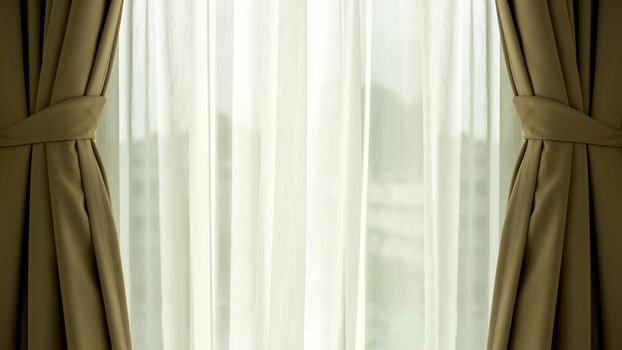In the world of event planning, attention to detail is crucial. Drapes play a significant role in creating the atmosphere for any event, whether a corporate gathering or a wedding. Quest Events is dedicated to providing excellent drape rental solutions and installation services. This guide will walk you through the steps to ensure your drapes are wrinkle-free and looking their best.
Jump Links
- Introduction: The Wrinkle Problem
- Factors Causing Wrinkles in Drapes
- Preparing Your Drapes for Wrinkle Treatment
- Wrinkle Removal Methods
- Re-hanging Your Drapes
- Conclusion: Enjoying Beautiful, Wrinkle-Free Drapes
- Drape Wrinkle Removal FAQs
Introduction: The Wrinkle Problem
In the meticulously crafted world of event planning, wrinkles on drapes are akin to an unwelcome guest. Drapes serve as a backdrop that ties the theme and ambiance of an event together. Whether it’s a corporate affair or a wedding, the drapes silently dictate the tone.
Wrinkles on drapes, however small, can be a sore sight and detract from the professional and polished image you wish to project. They can be a distraction and may even be perceived as a lack of attention to detail, which is why understanding and tackling the wrinkle problem is crucial for any event planner or organizer. In this guide, we will unravel the secrets to achieving immaculate, wrinkle-free drapes that will elevate the aesthetics of your events.
Importance of a Wrinkle-Free Drape
Draperies contribute substantially to the aesthetic and ambiance of an event. Whether you’re organizing a corporate function, a product launch, or a wedding, a crisply presented drape line can make the space look polished and professional. Wrinkle-free drapes signify meticulous effort has been put into preparing for the event. Furthermore, wrinkles can be particularly noticeable in photos at events where photography is prominent, so ensuring a smooth presentation is vital.
Factors Causing Wrinkles in Drapes
Wrinkles in drapes can be traced back to various origins, and understanding these factors is the first step in your wrinkle-combatting journey. Here’s a closer look at what might be causing those pesky wrinkles:
Improper Storage
One of the prime culprits behind wrinkled drapes is the way they are stored. When drapes are folded or crumpled and stored for extended periods, wrinkles are bound to form. It is essential to store drapes with care, ideally rolled around a tube or hung in a storage bag to maintain their smoothness.
Fabric Composition
Different materials have different propensities for wrinkling. For instance, natural fibers such as cotton or linen are more prone to wrinkles than synthetic materials like polyester. Understanding the fabric composition of your drapes will help you select the most suitable wrinkle-removal method.
Environmental Conditions
The environment plays a significant role in the condition of your drapes. Humidity can cause fabrics to absorb moisture, leading to wrinkles, while excessive dryness can make the material brittle. Moreover, if the drapes are exposed to sunlight for long periods, they may lose their structure and form wrinkles.
Handling and Installation
How the drapes are handled during installation can impact their appearance. Rough handling, stretching, or not following the manufacturer’s installation guidelines can cause wrinkles. Moreover, constantly opening and closing the drapes without proper care can contribute to wrinkling.
Laundry Practices
How drapes are cleaned and dried can also affect their wrinkle status. Overwashing, not adhering to fabric care instructions, or leaving them in the dryer for too long can prevent wrinkles from forming. It’s important to follow recommended cleaning procedures.
Inherent Wrinkles from Manufacturing
Sometimes, wrinkles result from manufacturing and are already present when the drapes are brand new. These wrinkles are usually due to how the fabric is handled during production and may require treatment before the drapes are ready for display.
Knowing what causes wrinkles in drapes equips you with the knowledge to prevent them in the first place or effectively deal with them when they do occur. Armed with this insight, you can make informed decisions about fabric choice, handling, cleaning, and storage to ensure your drapes always look impeccable.
Preparing Your Drapes for Wrinkle Treatment
Before you embark on the quest to banish wrinkles from your drapes, it is imperative to lay the groundwork by preparing them. This step is crucial to ensure that the wrinkle treatment is effective and does not cause any damage to the fabric. Start by carefully removing the drapes from their hanging position.
Next, assess the fabric type, as this will influence the method of wrinkle removal. Please ensure the drapes are clean; dust or vacuum them to remove dirt or particles. If the drapes have any specific cleaning instructions or care labels, take the time to read them. Also, inspect the drapes for any stains that need to be spot-cleaned before proceeding with wrinkle treatment. Adequately preparing your drapes will not only make the wrinkle-removal process smoother but also prolong the life and maintain the quality of the fabric.
Removing Drapes Safely and Accurately
Proper removal of the drapes is essential in preventing additional wrinkles or damage. Gently unhinge any clips or ties that are holding them in place. For larger or heavier drapes, it is advisable to have assistance to ensure they are appropriately handled.
Identifying the Drape Material
Before you can begin the wrinkle removal process, it’s essential to identify the fabric of your drapes. Different materials will require different care techniques. Check the labels for any specific cleaning instructions or restrictions.
Vacuuming or Dusting Before Treatment
Before treating the drapes for wrinkles, they should be clean. Use a gentle vacuum with an upholstery attachment or a soft duster to remove dust and debris. Also, look for any stains that may need spot cleaning.
Wrinkle Removal Methods
Once your drapes are prepared and primed, it’s time to delve into the various wrinkle-removal methods available. The choice of method should be tailored to the fabric type and the severity of the wrinkles. Standard wrinkle removal techniques include steaming, which is gentle on the fabric and highly effective for most drape materials.
Ironing is another option, especially for more stubborn wrinkles, but it requires careful handling to avoid damaging the fabric. Alternatively, using a dryer can be an efficient way to remove wrinkles from sturdy materials, and for more delicate fabrics, the mist and roll technique might be more suitable.
Each method has its own set of best practices and precautions essential for optimal results. In the following sections, we will explore these wrinkle-removal methods in detail to equip you with the know-how to make your drapes look immaculate.
Steaming Your Drapes
Steaming is an excellent method for removing wrinkles from drapes as it is gentle on the fabric and effective in smoothing out creases. When opting for this method, selecting the right steamer is crucial based on the fabric of your drapes. Once the steamer is ready, hang your drapes in an area that allows them to extend freely.
Steaming should be done systematically from top to bottom, ensuring the steamer doesn’t get too close to the fabric, which can cause water stains. It’s also important to use distilled or de-mineralized water in the steamer to minimize any risk of leaving marks. Following these guidelines will help you achieve impeccably smooth drapes that add grace and sophistication to your event space.
Choosing the Right Steamer
Select a steamer that is suited for your drape’s material. Use a powerful standing steamer for heavy drapes, while a handheld steamer would suffice for lighter fabrics.
Hanging and Steaming Instructions
Hang the drapes in an area with enough space to move freely. Start steaming from the top, moving slowly down the fabric. Be sure not to hold the steamer too close to the material to avoid water spots.
Avoiding Water Stains and Splotches
Prevent water stains by ensuring the steamer is held safely from the fabric. Additionally, use distilled or de-mineralized water in your steamer to reduce the risk of water stains.
Ironing Your Drapes
Picking the Correct Iron Setting
Choose the correct iron setting for your drape’s material. Lower temperatures are best for delicate fabrics, while higher settings can be used for heavier materials.
Ironing Techniques for Different Materials
Use smooth, even strokes when ironing. Consider placing a cloth between the iron and the drape for delicate fabrics.
Preventing Burn or Heat Damage
Always start at a lower temperature and gradually increase if necessary to avoid burning or damaging the fabric.
Using a Dryer to Remove Wrinkles
Suitable Materials for the Dryer Method
This method is best for durable fabrics. Check the label to ensure that the material can be tumble dried.
Proper Dryer Settings
Use a low-heat setting and include a damp towel or dryer sheets to help release wrinkles.
Adding Water and Fabric Softener to Reduce Wrinkles
Adding a few ice cubes or a damp towel can create steam within the dryer, helping to release wrinkles.
The Mist and Roll Technique
The Mist and Roll Technique is a gentle and effective method for removing wrinkles from delicate drapes without heat. It involves mixing water and fabric freshener in a spray bottle, then lightly misting onto the drapes.
After misting, the drapes are rolled tightly and allowed to sit for a while. This helps the fabric to relax and the wrinkles to release. Finally, the drapes are unrolled and hung back up to air dry. This technique benefits fabrics sensitive to heat or where steaming and ironing are not viable options.
Water and Fabric Freshener Mixture
Mix water with a small amount of fabric freshener in a spray bottle.
Rolling the Drapes to Release Wrinkles
After misting the drapes with the mixture, roll them gently. This can help to release wrinkles without using heat.
Hanging the Drapes Back up to Dry
Hang the drapes in an area with good airflow to allow them to dry correctly.
Re-hanging Your Drapes
Tips for a Smooth Re-installation
When re-hanging your drapes, ensure the clips or ties are secure and that the drapes are hung evenly. If using a rod, ensure it is sturdy and properly anchored.
Maintaining Wrinkle-Free Drapes
Regular Dusting and Cleaning
Keep your drapes looking their best by regularly dusting or vacuuming them.
Using Wrinkle Release Sprays
Consider using wrinkle-release sprays for touch-ups between cleanings.
Gently Re-adjusting After Opening or Closing
When opening or closing drapes, do so gently to prevent additional wrinkles.
Conclusion: Enjoying Beautiful, Wrinkle-Free Drapes
With the guidance provided, your drapes should now be wrinkle-free and radiant. The elegance and sophistication smoothly presented drapes bring to an event are unmatched. Remember to regularly maintain your drapes to ensure their beauty lasts through many events.
Quest Events is here to assist you with all your drape rental and installation needs. Contact us for further support and inquiries. Your events deserve nothing but excellence.
Drape Wrinkle Removal FAQs
Can I remove wrinkles from my drapes without taking them down?
Yes, you can. A handheld steamer is an excellent way to remove wrinkles without removing the drapes. However, make sure to use it cautiously and at a safe distance to avoid water stains. Alternatively, you can use a wrinkle-release spray for light touch-ups.
How often should I clean my drapes to keep them wrinkle-free?
It is advisable to clean drapes every few months to keep them in optimal condition. However, it also depends on the fabric and the environment where they are used. Regular dusting or vacuuming can help in maintaining them.
Is it safe to iron all types of drape materials?
No, it is not safe to iron all types of drape materials. The heat of an iron can damage delicate fabrics such as silk or sheer materials. Always check the care label for instructions, and when in doubt, opt for a steamer as it is gentler on fabrics.
What should I do if my drapes are too heavy or large to handle?
If your drapes are too heavy or oversized, it’s advisable to seek professional help or ask someone to assist you in handling them. Handling drapes with care is essential to avoid any damage or additional wrinkling.
Can wrinkles in drapes be prevented during storage?
Yes, wrinkles can be minimized during storage by either rolling the drapes around a cylindrical tube or hanging them straight in a garment bag. Avoid folding them, as this can cause creases. Also, storing them in a cool, dry place can help prevent wrinkles.


